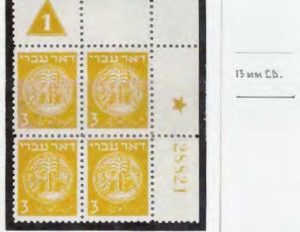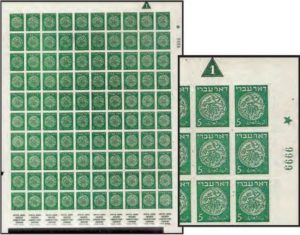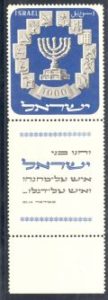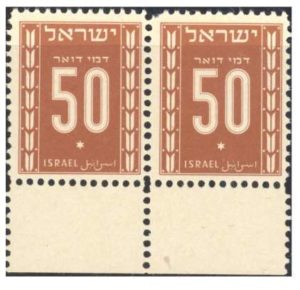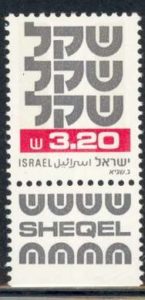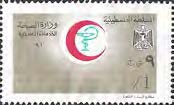Israel
Stamps
“The genesis of the Israel stamp is as dramatic and exciting as the history of the country itself.
Israel’s Postal Service began to function on May 16, 1948, the day after the State was established.
Two weeks earlier, the Jewish leaders in Palestine, preparing for the possibility of Jewish independence, began to plan stamps for the practical needs of a postal service. Usually, it takes months to produce a stamp, for the designing, the choice of colors, the technical work are all complex and time-consuming. The Jews in what was then still Palestine managed to bring out a stamp in less than twelve working days.
Where the first issue was unavailable, Jewish National Fund stamps, long used for purposes of fund-raising, were drafted for service in the two-month interim period of the gradual withdrawal of the British administration.
Israel’s first stamps did not contain the name of the State for they were prepared before the State was born and named. Thus, the first stamps of Israel carry only the phrase “Doar Ivri” (Hebrew mail).”
(Ribalow, p. 5) (NOTE: Extra line spacing for clarity)
1st Issue
Doar Ivri – 1st Coins w/TABS *
Complete Set 1 through 9
May 16, 1948
*See below “TABS ARE BORN”
“The coin stamps of Israel – like the actual coins of the new State – duplicate the designs and motifs of the ancient coins struck during the era of the Hasmoneans and the two rebellions of the Jews against the Roman Empire.”
(Ribalow, p. 6)
“As the new name of the State had not yet been decided, they inscribed the words DOAR IVRI, “Hebrew Post”, in Hebrew and Arabic and the value was printed in figures only. At the time, the unit of currency was in milliemes (or mils).”
“They started printing the stamps on May 4th by the typographical process.
. . . . .
As the proclamation was not issued until late in the day on Friday, May 14 and no work could (or would) be done on the Sabbath, the first stamps were issued on Sunday, May 16.”
“As many people would not understand the words on the ancient coins, it was decided to print a description of the bottom row of the selvedge – what collectors call the margins around the sheet of stamps. Thus the TAB was born . . . .”
(Morginstin, p. 18)
1st Issue
Doar Ivri – 1st Coins
3 mils, PLATE BLOCK
May 16, 1948
GROUP 12, PERF 11X11, JULY 1948, RANGE 28654 – 28571, THIN YELLOW PAPER
(Uria, p. 134)
1st Issue
Doar Ivri – 1st Coins
5 mils
SHEET w/”Exploded” PLATE BLOCK
May 16, 1948
Group 20, rouletted perforations
serial # 9999.
This is the last rouletted sheet printed.
The next serial # of 10000 is:
group #21 perforation 11×11
(Waide, p. 38)
TABS ARE BORN
As many people would not understand the words on the ancient coins, it was decided to print a description of the bottom row of the selvedge – what collectors call the margins around the sheet of stamps. Thus the TAB was born . . . . In the early years, collectors did not know what to make of the tabs so many tabs were torn off. The printing of tabs on the stamps continues to this day. Now please note this. On some early issues, the tab came in two parts: the descriptive tab itself and a small piece of selvedge. BOTH must be kept.
(Morginstin, pp. 18-19)
TABS ON POSTAGE DUES AND OFFICIAL STAMPS
On the POSTAGE DUES and OFFICIAL stamps, nothing was printed in the selvege. Nevertheless, the blank selvege is collected as if it were a tab.
(Morginstin, pp. 19)
Definitive Stamps
Shekel Stamp definitive
The definitive are issued many times. These are quite collectible as there are differences in paper and most notably phosphor tagging, used by the automated sorting and cancelling machines. The same basic stamp can have no phosphor bars, a bar on the right, a bar on the left or two bars. The differences were
required due to changing postal rates.
#133 Jewish History Overview of Palestine and Israel through Holy Land Stamps, Slide Show. Society of Israel Philatelists, www.israelstamps.com. 2010. Sid Morginstin. slide 72.
Palestinian Authority Revenue Stamp
Ministry of Health Red Crescent stamp, a value of 9. I am unsure if that value is in fils, dinars or shekels.
(Harris, p. 16)
ADDITIONAL PHILATELIC INFORMATION
Categories of Israeli Stamps
(Main Categories – Partial)
- Standard Stamps.
- Commemorative Stamps – issued once to indicate an event.
- Definitive Stamps – issued many times for standard postage.
- Airmail Stamps.
- Postage Due Stamps.
- Revenue Stamps.
- Official Stamps
NOTE: When needed standard postage (Commemorative and Definitive Stamps are used for the other categories).
Currency Changes
- 1948 – 1000 mils = 1 Lira.
- 1949 – 1000 pruta = 1 Lira.
- 1960 – 100 agora = 1 Lira.
- 1980 – 100 Agorot = 1 IS (Israel Sheqel).
- 1986 – 1000 IS = 1 NIS (New Israel Sheqel).
For additional information see the following.
REFERENCES
The History of Israel’s Postage Stamps (Stamps from 1948 to 1956). Harold U. Ribalow. Published by the Educational Fund, Society of Israel Philatelists, Inc. 2nd Printing. October 2014.
A Brief Overview of Holy Land Philately, Part 3. The Israel Philatelist. Summer, 2017. Sid Morginstin. p. 18-19.
Doar Ivri Gems. The Israel Philatelist, August 2012. Selwyn Uria. p. 134.
Gem of the Holy Land. The Israel Philatelist. April 2011. Doran Waide. p. 38.
ISRAELI INFLATION REFLECTED IN POSTAL RATES. The Israel Philatelist. Winter 2020. pp. 22-25.
BALE SPECIALIZED ISRAEL POSTAGE STAMPS CATALOGUE, 24th EDITION. Joseph D. Stier, Compiler and Editor. Chariot Global Marketing, Ltd. Tel Aviv, 2016.
#133 Jewish History Overview of Palestine and Israel through Holy Land Stamps, Slide Show. Society of Israel Philatelists, www.israelstamps.com. 2010. Sid Morginstin. slide 72.
Palestinian Authority Revenue Stamps. The Israel Philatelist. Fall 2019. Arthur Harris. p. 16.

![Hist-Israel-Post-Stamps-(1948-1956)[ONLY-PART-of-Book],2014--p-6-Doar-Ivri-Reg--w-TABS,-100-dpi B, 102K, 440 x 325](https://israelstamps.com/wp-content/uploads/Hist-Israel-Post-Stamps-1948-1956ONLY-PART-of-Book2014-p-6-Doar-Ivri-Reg-w-TABS-100-dpi-B-102K-440-x-325-300x222.jpg)
